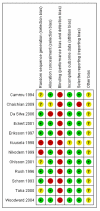Immersion in water in labour and birth
- PMID: 19370552
- PMCID: PMC3982045
- DOI: 10.1002/14651858.CD000111.pub3
Immersion in water in labour and birth
Update in
-
Immersion in water during labour and birth.Cochrane Database Syst Rev. 2018 May 16;5(5):CD000111. doi: 10.1002/14651858.CD000111.pub4. Cochrane Database Syst Rev. 2018. PMID: 29768662 Free PMC article.
Abstract
Background: Enthusiasts suggest that labouring in water and waterbirth increase maternal relaxation, reduce analgesia requirements and promote a midwifery model of care. Sceptics cite the possibility of neonatal water inhalation and maternal/neonatal infection.
Objectives: To assess the evidence from randomised controlled trials about immersion in water during labour and waterbirth on maternal, fetal, neonatal and caregiver outcomes.
Search strategy: We searched the Cochrane Pregnancy and Childbirth Group's Trials Register (October 2008).
Selection criteria: Randomised controlled trials comparing any bath tub/pool with no immersion during labour and/or birth.
Data collection and analysis: We assessed trial eligibility and quality and extracted data independently. One review author entered data and another checked for accuracy.
Main results: This review includes 11 trials (3146 women); eight related to the first stage of labour, one to the first and second stages, one to early versus late immersion in the first stage of labour, and another to the second stage. We identified no trials evaluating different baths/pools, or the management of third stage of labour.Results for the first stage of labour showed there was a significant reduction in the epidural/spinal/paracervical analgesia/anaesthesia rate amongst women allocated to water immersion compared to controls (478/1254 versus 529/1245; odds ratio (OR) 0.82, 95% confidence interval (CI) 0.70 to 0.98, six trials). There was no difference in assisted vaginal deliveries (OR 0.84, 95% CI 0.66 to 1.06, seven trials), caesarean sections (OR 1.23, 95% CI 0.86 to 1.75, eight trials), perineal trauma or maternal infection. There were no differences for Apgar score less than seven at five minutes (OR 1.59, 95% CI 0.63 to 4.01, five trials), neonatal unit admissions (OR 1.06, 95% CI 0.70 to 1.62, three trials), or neonatal infection rates (OR 2.01, 95% CI 0.50 to 8.07, five trials).A lack of data for some comparisons prevented robust conclusions. Further research is needed.
Authors' conclusions: Evidence suggests that water immersion during the first stage of labour reduces the use of epidural/spinal analgesia. There is limited information for other outcomes related to water use during the first and second stages of labour, due to intervention and outcome variability. There is no evidence of increased adverse effects to the fetus/neonate or woman from labouring in water or waterbirth. The fact that use of water immersion in labour and birth is now a widely available care option for women threatens the feasibility of a large, multicentre randomised controlled trial.
Figures
Update of
-
Immersion in water in pregnancy, labour and birth.Cochrane Database Syst Rev. 2004;(2):CD000111. doi: 10.1002/14651858.CD000111.pub2. Cochrane Database Syst Rev. 2004. Update in: Cochrane Database Syst Rev. 2009 Apr 15;(2):CD000111. doi: 10.1002/14651858.CD000111.pub3. PMID: 15106143 Updated.
Comment in
-
Immersion in water in labour and birth.Sao Paulo Med J. 2013;131(5):364. doi: 10.1590/1516-3180.20131315T2. Sao Paulo Med J. 2013. PMID: 24310807 Free PMC article.
References
-
- Cammu H, Clasen K, Van Wetteren L. Is having a warm bath during labour useful? Journal of Perinatal Medicine. 1992;20(Suppl 1):104.
- Cammu H, Clasen K, Van Wetteren L, Derde M. ‘To bathe or not to bathe’ during the first stage of labor. Acta Obstetricia et Gynecologica Scandinavica. 1994;73:468–72. - PubMed
-
- Chaichian S, Akhlaghi A, Rousta F, Safavi M. Experience of water birth delivery in Iran. Archives of Iranian Medicine. 2009;12(5):468–71. - PubMed
-
- Da Silva FM, De Oliveira SM. The effect of immersion baths on the length of childbirth labor [O efeito do banho de imersao na duracao do trabalho de parto] Revista da Escola de Enfermagem da USP. 2006;40(1):57–63. - PubMed
- Da Silva FMB, De Olivera SMJV, Nobre MRC. A randomised controlled trial evaluating the effect of immersion bath on labour pain. Midwifery. 2009;Vol. 25(issue 3):286–294. - PubMed
-
- Eckert K, Turnbull D, MacLennan A. Immersion in water in the first stage of labor: a randomised controlled trial. Birth. 2001;28(2):84–93. - PubMed
- Eckert KA, MacLennan AH, Turnbull DA. Immersion in water in the first stage of labour: a randomised controlled trial. 4th Annual Congress of the Perinatal Society of Australia & New Zealand; 1998 March 30-April 4; Australia: Alice Springs; 1998.
-
- Eriksson M, Mattson L, Ladfors L. Early or late bath during the first stage of labour: a randomised study of 200 women. Midwifery. 1997;13:146–8. - PubMed
- Ladfors L, Mattsson I, Eriksson M. Early or late tub bath during the first stage of labor: a randomized study of 200 women. American Journal of Obstetrics and Gynecology. 1997;176(1 Pt 2):S141. - PubMed
Publication types
MeSH terms
Substances
Grants and funding
LinkOut - more resources
Full Text Sources
Other Literature Sources
Medical



